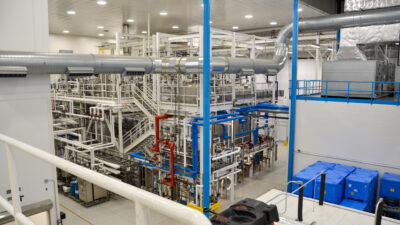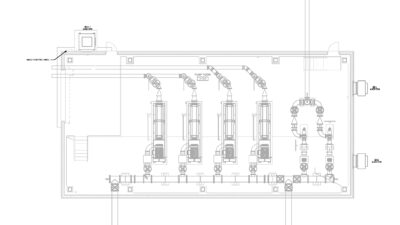Wastewater treatment plants and collection facilities are subject to various explosive, toxic and corrosive gas byproducts generated during decomposition of organic matter. Facility design must comply with NFPA 820 to reduce risks.
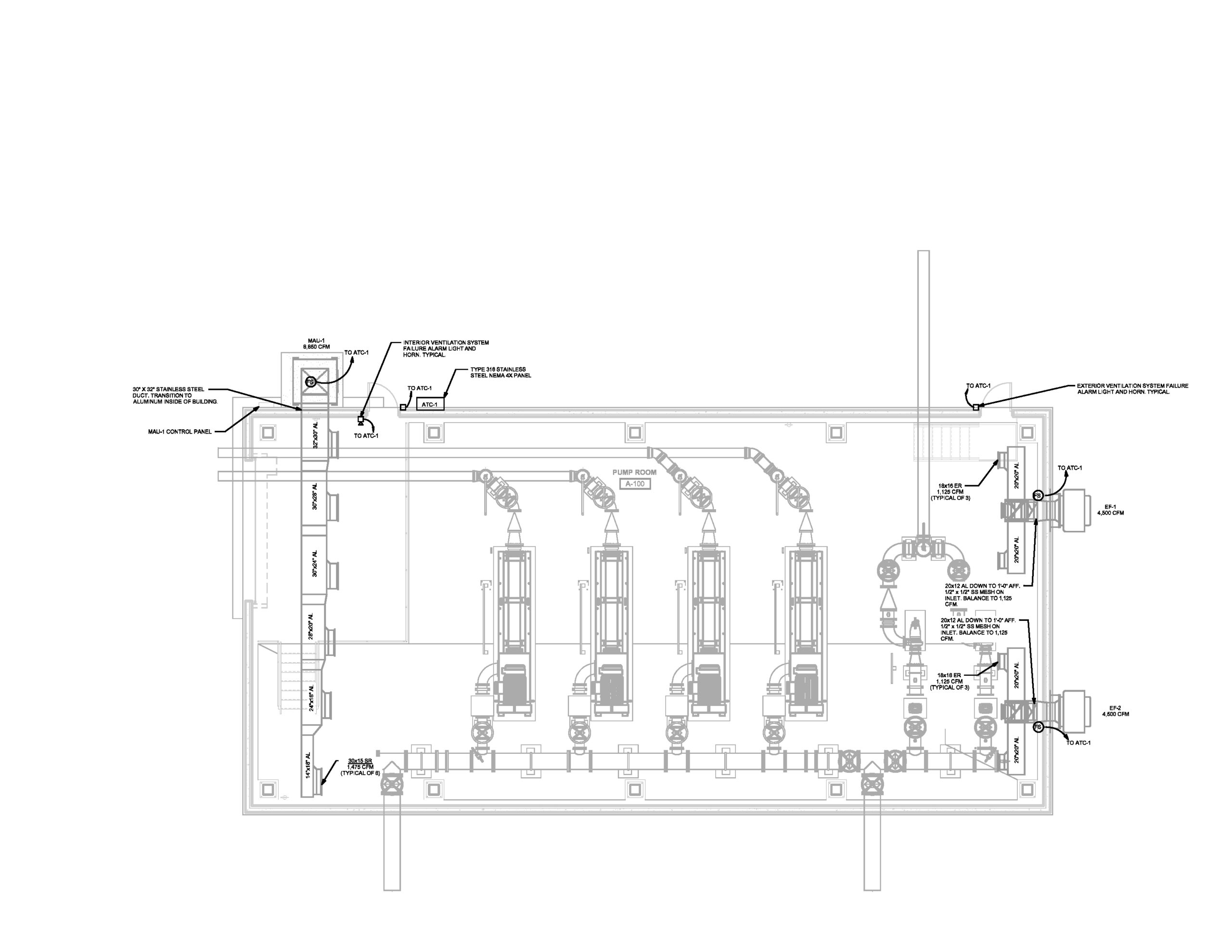
Learning objectives
- NFPA 820 requirements for designing safe wastewater treatment plants and collection facilities.
- Different hazardous space classifications and how to classify a space.
- Different methods for reducing electrical hazard classification in wastewater treatment.
NFPA 820 insights
- NFPA 820 is a critical standard for fire protection in wastewater treatment and collection facilities, helping engineers classify hazardous spaces, define ventilation requirements and select proper construction materials to mitigate the risk of fire and explosion from flammable gases.
- By establishing clear criteria for hazardous location classification and ventilation design, NFPA 820 works in conjunction with NFPA 70 to ensure wastewater facilities are safely constructed, operated and maintained.
A wastewater treatment plant (WWTP) is a facility designed to treat and clean wastewater before it is returned to the environment or reused. The primary goal of a WWTP is to remove contaminants from the water, making it safe for discharge into rivers, lakes or oceans or sometimes even for reuse in industrial or agricultural processes.
Decomposition of organic matter at a WWTP generates methane and hydrogen sulfide, both of which are flammable. During the wastewater treatment and collection process, the presence of flammable gas and vapors increases the risk of fire and explosion hazards. In 1985, the NFPA began developing NFPA 820: Recommended Practice for Fire Protection in Wastewater Treatment and Collection Facilities in response to explosions at multiple WWTPs. The first edition was issued in 1990; in 1995, the document was changed from a recommended practice to a mandatory standard.

Known today as NFPA 820: Standard for Fire Protection in Wastewater Treatment and Collection Facilities, this standard continues to develop and change to provide appropriate safety measures at wastewater facilities. NFPA 820 is an industry standard that applies to all new installations as well as additions or modifications to existing facilities. Each state or local jurisdiction determines if NFPA 820 is adopted as part of their building code.
For example, the Florida Fire Prevention Code consists of NFPA 1: Fire Code and NFPA 101: Life Safety Code with amendments. NFPA 1 requires that all “wastewater treatment and collection facilities comply with NFPA 820.”
Classifying hazardous spaces with NFPA 820
To determine the safety measures for a specific space, one must define the treatment or collection process occurring in that space and then determine the likelihood of a flammable or combustible concentration or quantity being present — this is known as classification of locations.
NFPA 820 provides defining space classifications for three different types of wastewater processes: collection systems, liquid stream treatment processes and solids treatment processes. NFPA 820 then breaks down each hazard classification by structure and process type. Each space and associated process is given a hazard classification as defined by NFPA 70: National Electrical Code (NEC) Article 500.
NEC defines three types of hazardous classified locations:
- Class I locations are defined as having flammable gases or vapors present in the air in sufficient quantities to be explosive or ignitable.
- Class II locations are areas that are hazardous owing to the presence of combustible dust.
- Class III locations are hazardous owing to the presence of easily ignitable fibers or filings typically associated with storage of these materials.
WWTPs are categorized as Class I because of the presence of flammable gases and vapors, such as methane. NFPA 70 also defines the conditions in which these hazards are present:
- Division 1: Normal conditions expect the hazard to be present in everyday activity.
- Division 2: Abnormal conditions only expect the hazard to be present through accidental rupture or breakage.
A space is considered unclassified (not Class I, II or III) when hazards are not present during normal operating conditions. The hazardous substances are then broken down into Groups A through G, which defines the explosion characteristics of the specific substance (see Table 1).
| Table 1: Classification of materials | |||
| Classes | Groups | Divisions | |
| 1 | 2 | ||
| Class I: Gases, vapors and liquids | A: Acetylene B: Hydrogen, etc. C: Ether, etc. D: Hydrocarbons, fuels, solvents, etc. | Normally explosive and hazardous | Not normally explosive, but may accidentally exist |
| Class II: Dusts | E: Metal dusts F: Carbon dusts G: Flour, starch, grain, combustible plastic or chemical dust | Ignitable quantities of dust normally in suspension | Dust not normally suspended in ignitable concentrations |
| Class III: Fibers | Textiles (easily ignitable) | Handled or used in manufacturing | Stored in storage |
Table 1: Classification breakdown of hazardous materials. This illustrates the different combinations of classes, divisions and groups comprising NFPA 70: National Electrical Code. Courtesy: CDM Smith
NFPA 820 also provides specific examples of structures and associated classifications and the extent of their classification envelope.
NFPA 820 ventilation requirements
NFPA 820 provides ventilation and alarm/monitoring guidelines within Chapter 9 for specific hazardous areas located within a WWTP. Each type of space and associated process is provided in a table that lists how the following specific ventilation rates affect the classification of the space:
- No ventilation or ventilating at less than 12 air changes per hour (ACH)
- Continuously ventilating at 12 ACH
- Continuously ventilating at 6 ACH
- No ventilation or ventilating at less than 6 ACH
For many processes, ventilation can reduce the classification to a lower level or declassify the space altogether.
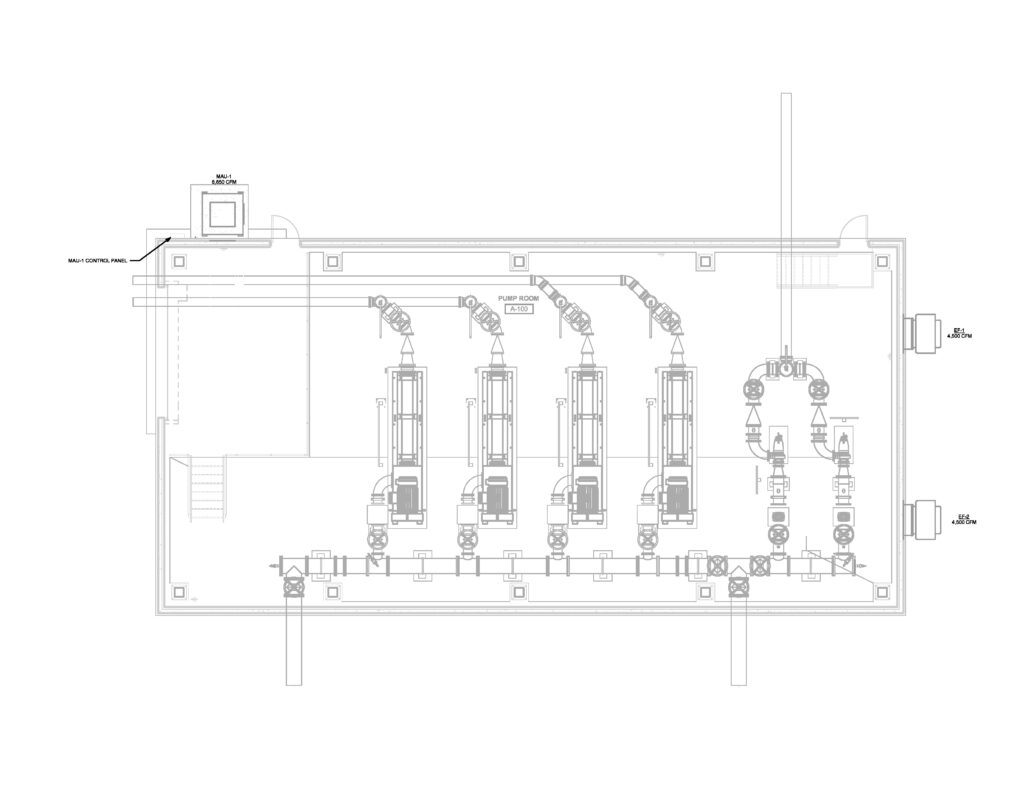
NFPA 820 determines the ventilation used to obtain the lowest electrical classification possible in accordance with the NEC. Ventilation systems must include both mechanical supply and exhaust and the ventilation system must operate continuously to reduce electrical classifications. The ACH that NFPA 820 requires is based on 100% outside supply air. This means the required ACH determines the supply cubic feet per minute (cfm) required for the space.
The best practice for routing ductwork in one of these spaces is to ensure proper cross ventilation — install the supply on one wall of the room and the exhaust on the opposite wall. Route the exhaust to provide both high and low (within 12 inches of the floor) air pickup points to capture fumes that are both lighter and heavier than air.
For typical NFPA 820-compliant designs, an engineer will specify a supply fan (or make-up air unit) for the required mechanical supply and an exhaust fan for the required mechanical exhaust. A supply fan is typically used for warmer climates, while a make-up air unit with heating coils is used for cooler climates. This allows for freeze protection of the space, equipment and piping during winter months because the space is continuously ventilated with outside air. In some cases, the exhaust air is brought to a local or central plant odor control system. These systems scrub the exhaust air of noxious fumes and release them at a high velocity into the atmosphere.
To maintain separation of classified spaces from unclassified spaces, NFPA 820 requires that ventilation systems serving unclassified locations adjacent to classified locations must be physically separated. Physical separation is defined as a gastight partition with no physical connection between the spaces and separate individual entry doors to each space from the exterior.
Additionally, a minimum differential pressure relative to ambient air pressure of 0.1 inches of water must be maintained under all operating conditions. Ventilation systems are not permitted to transfer air between unclassified interior spaces and classified interior spaces. An exception to this requirement is where an airlock is installed in accordance with Section 9.4 of NFPA 820.
Materials of construction
Based on the NEC classification rating mentioned above, electrical components and equipment placed in the space must meet the minimum hazard requirements of that space.
For example, any electrical component located in a Class 1 Division 2 space must meet that Class 1 Division 2 rating. NFPA 70 indicates that electrical equipment within a hazardous classified space must meet the requirements of Section 500.7, such as explosion-proof equipment, dust-ignition-proof equipment or hermetically sealed equipment. The type of equipment protection techniques allowed in a hazardous space are dependent on the classification of the space in which they are located. Ventilation fans serving hazardous locations must be Type A or B spark-resistant construction in accordance with the Air Movement and Control Association International.
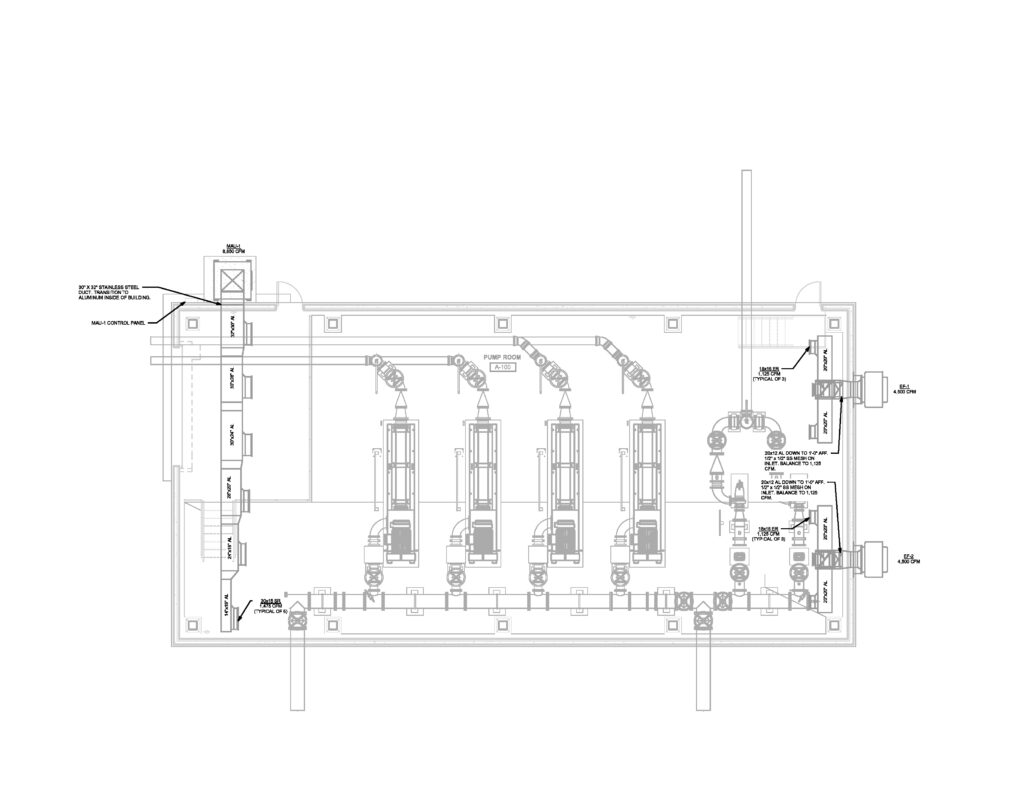
In some rare cases, it may be more cost-effective to omit ventilation to lower a space’s classification and instead, provide heavy-duty/spark-resistant construction materials within the space.
Regarding the heating, ventilation and air conditioning (HVAC) system, the ductwork is typically constructed of aluminum or stainless steel. For systems serving areas with exposed wastewater, coated stainless steel or fiber-reinforced plastic that can withstand a corrosive environment is typically used. Hydrogen sulfide and other corrosive compounds that are byproducts of the wastewater treatment process are incompatible with more cost-effective duct materials.
Fire and explosion prevention, protection via NFPA 820
Regardless of the airflow rate, flow sensors are required in supply and exhaust systems that are used to reduce electrical classification, thereby confirming that equipment is functioning continuously. NFPA 820 requires that ventilation monitoring is provided with an auxiliary power supply. The simplest of these sensors provide the information that there is flow within the ductwork system, proving that the fan is either on or off. When the flow sensor senses zero flow, an alarm is triggered.
Permanent combustible gas detection is required in some spaces. Combustible gas detectors and signaling systems must be provided with an auxiliary power supply to ensure continuous operation during any failure of the normal power supply. Additionally, as an added safety precaution, some facilities choose to provide their operators with portable combustible gas detectors. These devices alert the wearer if they are exposed to hazardous levels of gas.
Local alarms must be visible and audible and located at the entrances to the spaces and within the spaces. Visible-only dual light (go/no-go) alarms can be used at the entrances to remote spaces that are not constantly attended. Visible and audible alarms must also be monitored at a constantly attended location. The provision of the alarms is typically provided by a combination of building mechanical, electrical and automation.
For CDM Smith’s WWTP projects, building mechanical typically specifies the local alarm stations, electrical specifies the conduit and wire between the HVAC automatic temperature control panel and the programmable logic controllers, and the automation/controls team provides the process and instrumentation diagrams for the alarms monitored at a constantly attended location.
NFPA 820 previously included a requirement that mandated the installation of smoke detection systems in all supply and exhaust ductwork that provided ventilation with capacities greater than 2,000 cfm. This measure was put in place to enhance safety and ensure that any potential smoke or fire hazards in ventilation systems would be quickly identified.
However, in the 2024 revision of NFPA 820, this requirement was removed. The updated standard no longer mandates smoke detection within ventilation ductwork, reflecting a change in safety protocols or a reassessment of the necessity of such detection in these areas. The smoke detection requirement was updated to be consistent with the requirements of NFPA 90A: Standard for the Installation of Air-Conditioning and Ventilating Systems, which does not require smoke detectors for exhaust fans.
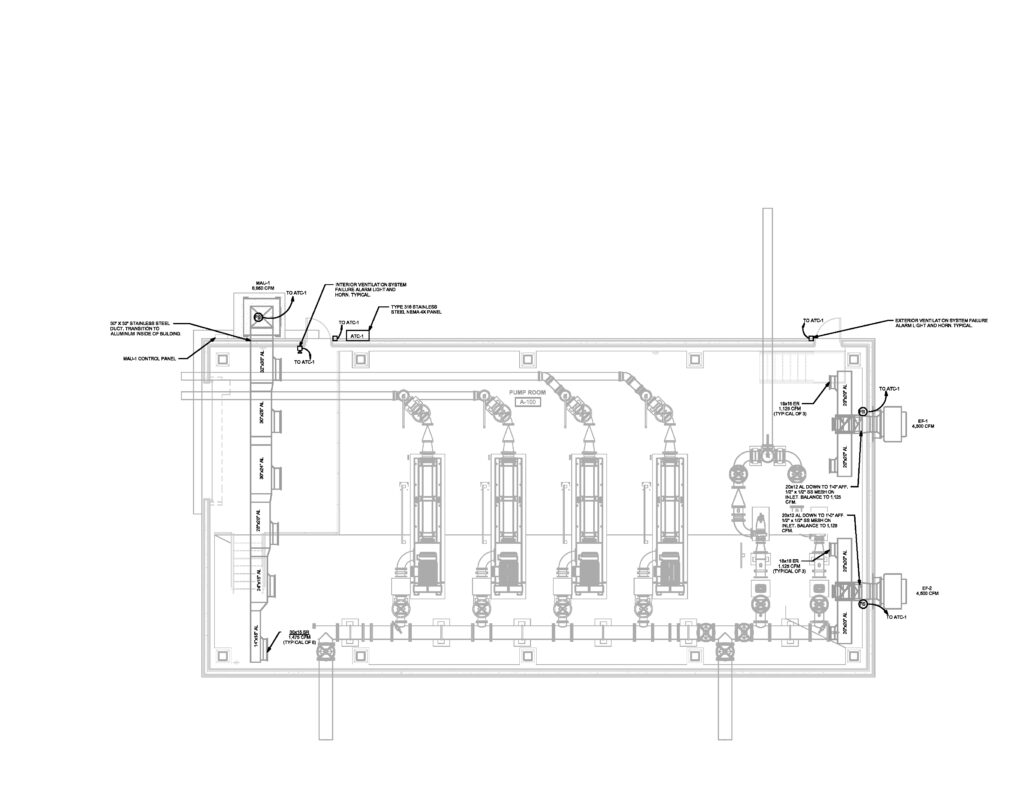
Along with ventilation, NFPA 820 defines requirements for fire and explosion prevention and protection measures according to each space and process type. Depending on the space and the defining wastewater process, NFPA 820 requires a fire alarm system, fire suppression system, fire hydrants, combustible gas detection system and/or portable fire extinguishers. In addition, NFPA 820 recommends providing an alarm that is triggered when failure of the primary power source occurs. The alarm sensors are monitored remotely and alert the local operator. A combination of visual and audible alarms is required.
Other methods to reduce electrical classification outside NFPA 820
Although providing ventilation to reduce the classification of a space is the typical method for reducing fire and explosion hazards within a WWTP, there are other methods that can be more cost-efficient in the long term. Nonetheless, these alternative methods come with their own drawbacks.
One method for reducing the risk of fire and explosion within a classified space is to remove the ignition source, such as locating electrical equipment outside of the classified areas. This requires an accurate classification of spaces in accordance with NFPA 70, Article 500.
However, this method is not always feasible because some electrical components and equipment must be installed in the space for specific operating processes, such as pumps and instrumentation. It is also important to pay attention to the boundary of the classification envelope and ensure the equipment is placed outside that boundary. The classified area can extend beyond the process equipment or even the process room. Class 1 Division 1 areas typically include a Class 1 Division 2 area before reaching an unclassified area.
| Table 2: Electrical area classifications | ||||
| AREA | Classification (NFPA 820-2024) | Classification with ventilation (NFPA 820-2024) | Fire protection measures | Notes |
| Blending basin pump station pump room | Class 1 division 2 Table 6.2.2A row 9A | Unclassified Table 6.2.2A row 9B with 6 ACH | H and FE | Wet and corrosive |
| Abbreviations: ACH: Air changes per hour FE: Portable fire extinguisher H: Hydrant protection | ||||
Table 2: Classification of pump station electrical areas. Courtesy: CDM Smith
Reducing the amount of ventilation needed for space can reduce costs associated with space heating and exhaust scrubbing. By cordoning hazardous locations via physical separations into smaller areas within a large facility, the volume of space needed to be ventilated is reduced. Ultimately, this can make ventilating a space more energy-efficient and cost-efficient and, therefore, more achievable.
However, it is important to understand the classification bubble and its extents for different structure types (as previously indicated) to ensure compliance with NFPA 70, Article 500 and NFPA 820. Some classified areas illustrate the classification bubble extending outside of the structure.
NFPA 820 allows the reduction of ventilation rates by 50% when the outdoor temperature is less than 50°F, when the space is unoccupied and when there are no combustible gases present in the space. This method is typically implemented in northern climates to reduce heating costs.
It is also important to implement maintenance and housekeeping methods to reduce the risk of ignition possibilities. Controlling dust or vapor accumulation and regularly inspecting equipment helps prevent the possibility of an accidental malfunction hazard.
To reduce the risk of explosions at WWTPs, NFPA 820 was created to provide guidance to engineers designing these spaces. Ventilation is a key method to diminish these hazards and make the WWTPs safer for both operators and the local community surrounding the facilities. There are multiple methods for reducing a space’s classification outside of NFPA 820 requirements, and it is important to consider the energy and cost of reducing a space’s classification via ventilation methods versus the cost of installing rated electrical equipment.
